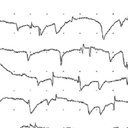Camurati-Engelmann disease (progressive diaphyseal dysplasia) in a Moroccan family.
Açar sözlər
Mücərrəd
We report on a 46-year-old mother of Moroccan origin, suffering mainly from painful, swollen legs, and her 26-year-old son who had experienced intense pain in his legs, without fever, for approximately 3 years. They did not have dysmorphic features or abnormal gaits. Radiographic studies of the mother revealed diaphyseal sclerosis of the tibia and spondylosis of the thoracal and lumbar vertebrae. The son had sclerosis of the diaphyses of the metacarpalia of the left hand, the femur and the fibula. The other parts of the skeleton were normal. Several osteosclerotic/hyperostotic disorders, such as melorheostosis (present mostly in sporadic cases and affecting lower extremities) and van Buchem's disease (autosomal recessive and commonly affecting the mandible) were considered as a diagnosis in the proposita. However, similar symptoms in the son of the proposita suggested an autosomal dominant inheritance pattern. This brought us to the diagnosis of progressive diaphyseal dysplasia (PDD) or Camurati-Engelmann disease (CED), an autosomal dominant disorder characterized by limb pain, reduced muscle mass, weakness, a waddling gait, progressive periosteal and endosteal sclerosis of the diaphyses of the long bones and sclerosis of the skull base. Mutations in the transforming growth factor (TGF)-beta1 gene on chromosome 19q13.1 have been reported to cause this disorder. The diagnosis of PDD/CED in this family was confirmed at the molecular level by detection of a C-to-T transition at position 466, leading to an arginine-to-cysteine amino acid change (position 156) in exon 2 of the transforming growth factor-beta1 (TGFB1) gene.


